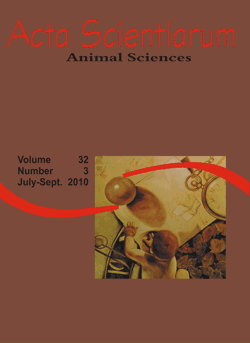<b>Perfomance of female Bergamasca lambs submitted to two artificial weaning systems</b> - doi: 10.4025/actascianimsci.v32i3.7359
Keywords:
economic analysis, weight gain, milk production, ewe-lambs
Abstract
This study used 26 Bergamasca ewe lambs weaned at 60 days of age and separated into 2 groups – Artificial suckling: 10 ewes separated from their dams 48 hours after delivery and fed with cow’s milk; Controlled suckling: 16 ewe lambs remained with their dams at pasture during the day and then separated at night, returning after morning milking. Following weaning, both groups were confined until they reached 38.6 kg average weight, and then separated into two types of treatment: Pasture rearing: 5 ewes from artificial suckling + 8 ewes from controlled suckling; Confined rearing: 5 ewes from artificial suckling + 8 ewes from controlled suckling. The experimental design was a 2 x 2 factorial, randomized. Average daily milk production for artificial suckling (0.318 kg) was higher than controlled suckling (0.256 kg). The economic return of the controlled suckling treatment was 8.13% higher than for artificial suckling. With regard to the pasture rearing and confined rearing treatment systems, there was no estrus for pasture rearing during experimental period. There was no difference between the weaning systems with regard to eggs per gram. The weaning system influenced the milk production of primiparous females.Downloads
Download data is not yet available.
Published
2010-09-02
How to Cite
Maestá, S. A., Siqueira, E. R. de, Fernandes, S., Emediato, R. M. de, Oliveira, A. A. de, & Stradiotto, M. de M. (2010). <b>Perfomance of female Bergamasca lambs submitted to two artificial weaning systems</b> - doi: 10.4025/actascianimsci.v32i3.7359. Acta Scientiarum. Animal Sciences, 32(3), 317-321. https://doi.org/10.4025/actascianimsci.v32i3.7359
Issue
Section
Animal Production
DECLARATION OF ORIGINALITY AND COPYRIGHTS
- I Declare that current article is original and has not been submitted for publication, in part or in whole, to any other national or international journal.
The copyrights belong exclusively to the authors. Published content is licensed under Creative Commons Attribution 4.0 (CC BY 4.0) guidelines, which allows sharing (copy and distribution of the material in any medium or format) and adaptation (remix, transform, and build upon the material) for any purpose, even commercially, under the terms of attribution.
Read this link for further information on how to use CC BY 4.0 properly.
0.9
2019CiteScore
29th percentile
Powered by 








































